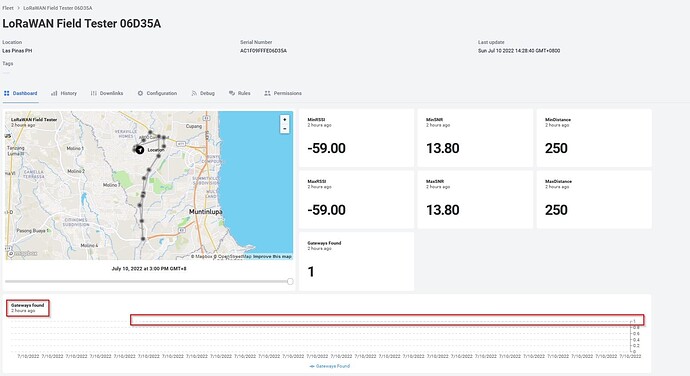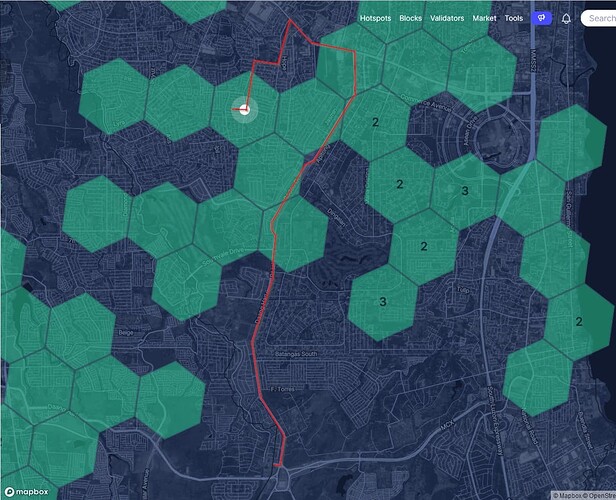Issue :
Hi, I’m struggling with connection using OTAA example code on Rak4631 module on a longfi network from Helium on region AU915 (Brazil) but no matter what I do it keeps returning OTAA Join Failed after the set number of tryies.
Setup :
AU915 sub band 2 (already tried sub band 5, 4 and 8 as hotspots nearby where transmitting their beacon on those bands accordingly to the helium explorer webapp) without success.
Docs :
Using code from: longfi-platformio/main.cpp at master · helium/longfi-platformio · GitHub
Details :
Here is what aways happens
14:35:55.844 > <BRD> SyncWord = 2414
14:35:55.844 > <BRD> LoRa Task started
14:35:55.844 > =====================================
14:35:55.844 > Welcome to RAK4630 LoRaWan!!!
14:35:55.844 > Type: OTAA
14:35:55.844 > Region: AU915
14:35:55.844 > =====================================
14:35:55.845 > <LMH> OTAA
14:35:55.845 > DevEui=60-81-F9-E1-A5-E8-C8-1B
14:35:55.845 > DevAdd=00000000
14:35:55.845 > AppEui=60-81-F9-5E-95-44-90-82
14:35:55.845 > AppKey=XX-XX-XX (here I have defined based on Helium Console keys as MSB)
14:35:55.918 > <LMH> Selected subband 2
14:35:56.918 > <LMH> Selected subband 2
14:35:57.918 > Starting Join
14:35:57.940 > Return from join
14:35:58.311 > <LM> OnRadioTxDone
14:35:58.313 > <LM> OnRadioTxDone => RX Windows #1 4991 #2 6002
14:35:58.313 > <LM> OnRadioTxDone => TX was Join Request
14:36:03.311 > <RADIO> RX window timeout = 3000
14:36:07.274 > <RADIO> RadioIrqProcess => IRQ_RX_TX_TIMEOUT
14:36:07.274 > <LM> OnRadioRxTimeout
14:36:07.436 > <LM> Join network failed 1 time(s)
14:36:07.436 >
14:36:35.435 > <LM> OnRadioTxDone
14:36:35.436 > <LM> OnRadioTxDone => RX Windows #1 4991 #2 6002
14:36:35.437 > <LM> OnRadioTxDone => TX was Join Request
14:36:40.435 > <RADIO> RX window timeout = 3000
14:36:44.395 > <RADIO> RadioIrqProcess => IRQ_RX_TX_TIMEOUT
14:36:44.395 > <LM> OnRadioRxTimeout
14:36:44.560 > <LM> Join network failed 2 time(s)
14:36:44.560 >
14:37:12.558 > <LM> OnRadioTxDone
14:37:12.559 > <LM> OnRadioTxDone => RX Windows #1 4991 #2 6002
14:37:12.560 > <LM> OnRadioTxDone => TX was Join Request
14:37:17.558 > <RADIO> RX window timeout = 3000
14:37:21.519 > <RADIO> RadioIrqProcess => IRQ_RX_TX_TIMEOUT
14:37:21.519 > <LM> OnRadioRxTimeout
14:37:21.683 > <LM> Join network failed 3 time(s)
14:37:21.683 >
14:37:21.683 > <LM> LoRaMacState = idle
14:37:21.683 > OTAA join failed!
14:37:21.683 > Check your EUI's and Keys's!
14:37:21.683 > Check if a Gateway is in range!
Code :
/**
* file LoRaWAN_OTAA_ABP.ino
* author rakwireless.com
* brief LoRaWan node example with OTAA/ABP registration
* version 0.1
* date 2020-08-21
*
* copyright Copyright (c) 2020
*
* note RAK4631 GPIO mapping to nRF52840 GPIO ports
RAK4631 <-> nRF52840
WB_IO1 <-> P0.17 (GPIO 17)
WB_IO2 <-> P1.02 (GPIO 34)
WB_IO3 <-> P0.21 (GPIO 21)
WB_IO4 <-> P0.04 (GPIO 4)
WB_IO5 <-> P0.09 (GPIO 9)
WB_IO6 <-> P0.10 (GPIO 10)
WB_SW1 <-> P0.01 (GPIO 1)
WB_A0 <-> P0.04/AIN2 (AnalogIn A2)
WB_A1 <-> P0.31/AIN7 (AnalogIn A7)
*/
#include <Arduino.h>
#include <LoRaWan-RAK4630.h>
#include <SPI.h>
// RAK4630 supply two LED
#ifndef LED_BUILTIN
#define LED_BUILTIN 35
#endif
#ifndef LED_BUILTIN2
#define LED_BUILTIN2 36
#endif
bool doOTAA = true; // OTAA is used by default.
#define SCHED_MAX_EVENT_DATA_SIZE APP_TIMER_SCHED_EVENT_DATA_SIZE /**< Maximum size of scheduler events. */
#define SCHED_QUEUE_SIZE 60 /**< Maximum number of events in the scheduler queue. */
#define LORAWAN_DATERATE DR_0 /*LoRaMac datarates definition, from DR_0 to DR_5*/
#define LORAWAN_TX_POWER TX_POWER_5 /*LoRaMac tx power definition, from TX_POWER_0 to TX_POWER_15*/
#define JOINREQ_NBTRIALS 3 /**< Number of trials for the join request. */
DeviceClass_t g_CurrentClass = CLASS_A; /* class definition*/
LoRaMacRegion_t g_CurrentRegion = LORAMAC_REGION_AU915; /* Region:EU868*/
lmh_confirm g_CurrentConfirm = LMH_UNCONFIRMED_MSG; /* confirm/unconfirm packet definition*/
uint8_t gAppPort = LORAWAN_APP_PORT; /* data port*/
/**brief Structure containing LoRaWan parameters, needed for lmh_init()
*/
static lmh_param_t g_lora_param_init = {LORAWAN_ADR_ON, LORAWAN_DATERATE, LORAWAN_PUBLIC_NETWORK, JOINREQ_NBTRIALS, LORAWAN_TX_POWER, LORAWAN_DUTYCYCLE_ON};
// Foward declaration
static void lorawan_has_joined_handler(void);
static void lorawan_join_failed_handler(void);
static void lorawan_rx_handler(lmh_app_data_t *app_data);
static void lorawan_confirm_class_handler(DeviceClass_t Class);
static void send_lora_frame(void);
/**brief Structure containing LoRaWan callback functions, needed for lmh_init()
*/
static lmh_callback_t g_lora_callbacks = {BoardGetBatteryLevel, BoardGetUniqueId, BoardGetRandomSeed,
lorawan_rx_handler, lorawan_has_joined_handler, lorawan_confirm_class_handler, lorawan_join_failed_handler
};
//OTAA keys !!!! KEYS ARE MSB !!!!
uint8_t nodeDeviceEUI[8] = {0x60, 0x81, 0xF9, 0xE1, 0xA5, 0xE8, 0xC8, 0x1B};
uint8_t nodeAppEUI[8] = {0x60, 0x81, 0xF9, 0x5E, 0x95, 0x44, 0x90, 0x82};
uint8_t nodeAppKey[16] = {0x12, 0xAC, 0x1F, 0xA5, 0x42, 0xF1, 0x85, 0x3A, 0x99, 0xB7, 0xEB, 0xD5, 0xEE, 0xB4, 0x7A, 0xC8};
// ABP keys
uint32_t nodeDevAddr = 0x260116F8;
uint8_t nodeNwsKey[16] = {0x7E, 0xAC, 0xE2, 0x55, 0xB8, 0xA5, 0xE2, 0x69, 0x91, 0x51, 0x96, 0x06, 0x47, 0x56, 0x9D, 0x23};
uint8_t nodeAppsKey[16] = {0xFB, 0xAC, 0xB6, 0x47, 0xF3, 0x58, 0x45, 0xC7, 0x50, 0x7D, 0xBF, 0x16, 0x8B, 0xA8, 0xC1, 0x7C};
// Private defination
#define LORAWAN_APP_DATA_BUFF_SIZE 64 /**< buffer size of the data to be transmitted. */
#define LORAWAN_APP_INTERVAL 20000 /**< Defines for user timer, the application data transmission interval. 20s, value in [ms]. */
static uint8_t m_lora_app_data_buffer[LORAWAN_APP_DATA_BUFF_SIZE]; //< Lora user application data buffer.
static lmh_app_data_t m_lora_app_data = {m_lora_app_data_buffer, 0, 0, 0, 0}; //< Lora user application data structure.
TimerEvent_t appTimer;
static uint32_t timers_init(void);
static uint32_t count = 0;
static uint32_t count_fail = 0;
void setup()
{
pinMode(LED_BUILTIN, OUTPUT);
digitalWrite(LED_BUILTIN, LOW);
// Initialize Serial for debug output
time_t timeout = millis();
Serial.begin(115200);
while (!Serial)
{
if ((millis() - timeout) < 5000)
{
delay(100);
}
else
{
break;
}
}
// Initialize LoRa chip.
lora_rak4630_init();
Serial.println("=====================================");
Serial.println("Welcome to RAK4630 LoRaWan!!!");
if (doOTAA)
{
Serial.println("Type: OTAA");
}
else
{
Serial.println("Type: ABP");
}
switch (g_CurrentRegion)
{
case LORAMAC_REGION_AS923:
Serial.println("Region: AS923");
break;
case LORAMAC_REGION_AU915:
Serial.println("Region: AU915");
break;
case LORAMAC_REGION_CN470:
Serial.println("Region: CN470");
break;
case LORAMAC_REGION_CN779:
Serial.println("Region: CN779");
break;
case LORAMAC_REGION_EU433:
Serial.println("Region: EU433");
break;
case LORAMAC_REGION_IN865:
Serial.println("Region: IN865");
break;
case LORAMAC_REGION_EU868:
Serial.println("Region: EU868");
break;
case LORAMAC_REGION_KR920:
Serial.println("Region: KR920");
break;
case LORAMAC_REGION_US915:
Serial.println("Region: US915");
break;
case LORAMAC_REGION_RU864:
Serial.println("Region: RU864");
break;
case LORAMAC_REGION_AS923_2:
Serial.println("Region: AS923-2");
break;
case LORAMAC_REGION_AS923_3:
Serial.println("Region: AS923-3");
break;
case LORAMAC_REGION_AS923_4:
Serial.println("Region: AS923-4");
break;
}
Serial.println("=====================================");
//creat a user timer to send data to server period
uint32_t err_code;
err_code = timers_init();
if (err_code != 0)
{
Serial.printf("timers_init failed - %d\n", err_code);
return;
}
// Setup the EUIs and Keys
if (doOTAA)
{
lmh_setDevEui(nodeDeviceEUI);
lmh_setAppEui(nodeAppEUI);
lmh_setAppKey(nodeAppKey);
}
else
{
lmh_setNwkSKey(nodeNwsKey);
lmh_setAppSKey(nodeAppsKey);
lmh_setDevAddr(nodeDevAddr);
}
// Initialize LoRaWan
err_code = lmh_init(&g_lora_callbacks, g_lora_param_init, doOTAA, g_CurrentClass, g_CurrentRegion);
if (err_code != 0)
{
Serial.printf("lmh_init failed - %d\n", err_code);
return;
}
delay(1000);
/* Helium Network LoraWan sub channel 2 is recommended, default channels 0-7*/
if (!lmh_setSubBandChannels(2))
{
Serial.println("lmh_setSubBandChannels() failed");
}
delay(1000);
// Start Join procedure
Serial.println("Starting Join");
lmh_join();
Serial.println("Return from join");
}
void loop()
{
// Put your application tasks here, like reading of sensors,
// Controlling actuators and/or other functions.
}
/**brief LoRa function for handling HasJoined event.
*/
void lorawan_has_joined_handler(void)
{
if(doOTAA == true)
{
Serial.println("OTAA Mode, Network Joined!");
}
else
{
Serial.println("ABP Mode");
}
lmh_error_status ret = lmh_class_request(g_CurrentClass);
if (ret == LMH_SUCCESS)
{
delay(1000);
TimerSetValue(&appTimer, LORAWAN_APP_INTERVAL);
TimerStart(&appTimer);
}
}
/**brief LoRa function for handling OTAA join failed
*/
static void lorawan_join_failed_handler(void)
{
Serial.println("OTAA join failed!");
Serial.println("Check your EUI's and Keys's!");
Serial.println("Check if a Gateway is in range!");
}
/**brief Function for handling LoRaWan received data from Gateway
*
* param[in] app_data Pointer to rx data
*/
void lorawan_rx_handler(lmh_app_data_t *app_data)
{
Serial.printf("LoRa Packet received on port %d, size:%d, rssi:%d, snr:%d, data:%s\n",
app_data->port, app_data->buffsize, app_data->rssi, app_data->snr, app_data->buffer);
}
void lorawan_confirm_class_handler(DeviceClass_t Class)
{
Serial.printf("switch to class %c done\n", "ABC"[Class]);
// Informs the server that switch has occurred ASAP
m_lora_app_data.buffsize = 0;
m_lora_app_data.port = gAppPort;
lmh_send(&m_lora_app_data, g_CurrentConfirm);
}
void send_lora_frame(void)
{
if (lmh_join_status_get() != LMH_SET)
{
//Not joined, try again later
return;
}
uint32_t i = 0;
memset(m_lora_app_data.buffer, 0, LORAWAN_APP_DATA_BUFF_SIZE);
m_lora_app_data.port = gAppPort;
m_lora_app_data.buffer[i++] = 'H';
m_lora_app_data.buffer[i++] = 'e';
m_lora_app_data.buffer[i++] = 'l';
m_lora_app_data.buffer[i++] = 'l';
m_lora_app_data.buffer[i++] = 'o';
m_lora_app_data.buffer[i++] = '!';
m_lora_app_data.buffsize = i;
lmh_error_status error = lmh_send(&m_lora_app_data, g_CurrentConfirm);
if (error == LMH_SUCCESS)
{
count++;
Serial.printf("lmh_send ok count %d\n", count);
}
else
{
count_fail++;
Serial.printf("lmh_send fail count %d\n", count_fail);
}
}
/**brief Function for handling user timerout event.
*/
void tx_lora_periodic_handler(void)
{
TimerSetValue(&appTimer, LORAWAN_APP_INTERVAL);
TimerStart(&appTimer);
Serial.println("Sending frame now...");
send_lora_frame();
}
/**brief Function for the Timer initialization.
*
* details Initializes the timer module. This creates and starts application timers.
*/
uint32_t timers_init(void)
{
TimerInit(&appTimer, tx_lora_periodic_handler);
return 0;
}
Platformio configuration:
; PlatformIO Project Configuration File
;
; Build options: build flags, source filter
; Upload options: custom upload port, speed and extra flags
; Library options: dependencies, extra library storages
; Advanced options: extra scripting
;
[platformio]
default_envs = wiscore_rak4631_v2
[env]
build_flags =
-D DEBUG=1
-D LIB_DEBUG=1
[env:wiscore_rak4631_v2]
platform = nordicnrf52
board = wiscore_rak4631
framework = arduino
lib_deps = beegee-tokyo/SX126x-Arduino@^2.0.11
Am I forgetting to configure something? I have already tried to enable duty cycle wondering if 3000ms is a RX window too short (as I saw in other topics it may cause a delay on RxTimeout of 65s but independently of LORAWAN_DUTYCYCLE_ON or LORAWAN_DUTYCYCLE_OFF the timeout is the same on region AU915. Thanks in advance for any help.



 hope this could be prevented or at least had some tool to put these devices under investigation once they put all coverage - the main purpose of this network - at risk.
hope this could be prevented or at least had some tool to put these devices under investigation once they put all coverage - the main purpose of this network - at risk.